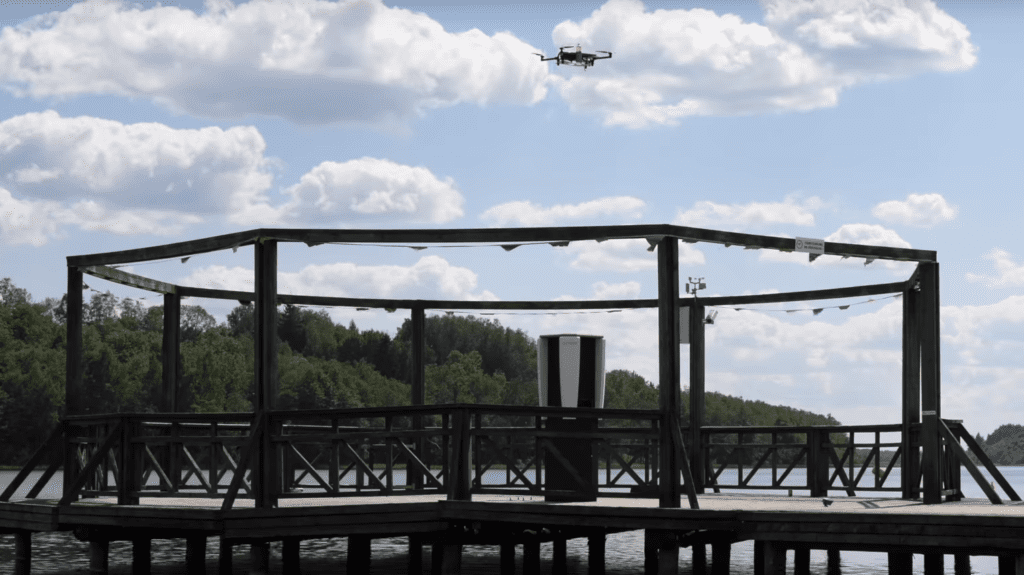
Estonia hires Airmap to consult on drone regulation and airspace integration. Pictured: Cleveron drone delivers water to Viljandi beach in Estonia. (Cleveron)
Estonia’s Air Navigation Services (EANS) has hired AirMap to help develop effective regulations around unmanned aircraft and integrate them into its airspace, making EANS the second air navigation service provider AirMap has consulted for on drone integration — a potentially lucrative market, with many interested parties in Europe and the Middle East.
Working with EANS, AirMap is following a “Business & Solution Design” template it released to the public, which includes conducting a market and stakeholder assessment, regulatory analysis, business plan, creation of a concept-of-operations and finally a rollout of unmanned traffic management (UTM) or U-space services.
“There were a lot of questions [from ANSPs] about the business model for UTM and unmanned services, and how do we work on adjusting the regulations that are required, and what does my organization need to look like in order to be able to manage unmanned traffic as well as regular manned traffic,” Eric McCabe, vice president of strategic services at AirMap, told Avionics International. “We got a lot of those questions, and so we said there’s a need for some consulting services to come in and work with the ANSP and work with others in the market to help define and answer some of these questions.”
Estonia has one of the more advanced drone ecosystems in Europe, as one of the few countries that enables flights beyond the operator’s visual line of sight (BVLOS) outside of controlled airspace, according to McCabe. Native company Cleveron provides last-mile drone delivery to predetermined drop-off spots for businesses, while Threod Systems develops VTOL and catapult-launched drones for surveillance purposes that are capable of notifying the user of handheld radios and similar technology on the ground.
McCabe said Estonia’s U-space system is likely to function similarly to the nationwide U-space system deployed by Switzerland’s Skyguide earlier this year, which was AirMap’s first ANSP client for drone integration consulting services. The Swiss system includes a flight information management system (FIMS), a cloud-based data exchange hub, allowing various unmanned service providers to connect with and receive information from Skyguide’s ATM systems.

A diagram showing the basic UTM concept being deployed in Switzerland. Photo: AirMap
That system was designed around the U-space model concepts created and demonstrated by the EU Single European Sky ATM Research Joint Undertaking, or SESAR-JU, Gulf of Finland U-space demonstration project, for which Estonia was the lead nation. The SESAR-JU project showcased seven advanced drone operations in Finland and Estonia. During the final demonstration in August of this year, urban air mobility designer Volocopter performed a piloted air taxi flight at Helsinki International Airport.
McCabe is hopeful Estonia will be able to deploy U-space services in Estonia in 2020, though the European Aviation Safety Agency (EASA)’s draft opinion on U-space regulations, scheduled for release this week at Amsterdam Drone Week, has been pushed back to February 2020 after it received more than 2,800 comments, according to EASA.
“I know they want to be fast,” McCabe said. “Estonia likes to be one of the first countries to do things electronically and digitally.”
 | Want more eVTOL and air taxi news? Sign up for our brand new e-letter, “The Skyport,” where every other week you’ll find the most important analysis and insider scoops from the urban air mobility world. |
But that speed may be stymied by fundamental disagreements between EU member states on how to design a U-space system and what role third-party UTM service providers such as AirMap will play in the ecosystem. Estonia, Switzerland and many other European nations favor an open competition system, allowing multiple UTM providers to compete for market share while all data is shared through a system like Switzerland’s FIMS, while some EU countries would prefer a single, nationalized system or a competition that favors the provision of unmanned airspace management services by domestic companies.